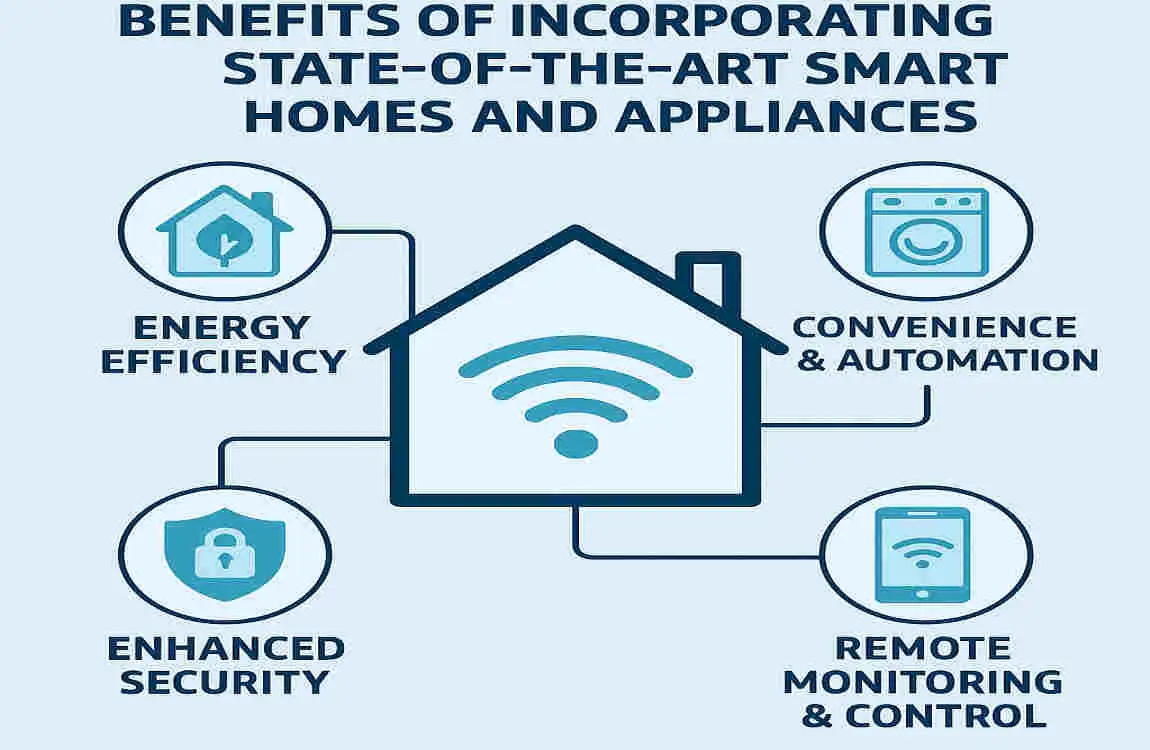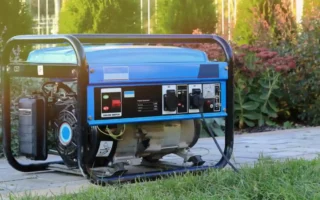In recent years, smart homes and appliances have revolutionized the way we live. From controlling the temperature with a simple voice command to automating household chores, these technologies have come a long way.
Understanding State-of-the-Art Smart Home and Appliances

What Does “State of the Art” Mean in Smart Home Technology?
When we talk about “state of the art” in smart home technology, we’re referring to the most advanced, cutting-edge solutions available. These devices incorporate the latest advancements in artificial intelligence, automation, and connectivity to provide users with unparalleled control and convenience.
Key Characteristics of Advanced Smart Appliances
State-of-the-art smart appliances seamlessly integrate with other devices and systems in your home. They often feature AI integration, allowing them to learn from your habits and preferences to provide a more personalized experience. Automation is another key aspect, enabling these devices to perform tasks without your intervention. Finally, connectivity is crucial, as it allows your appliances to communicate with each other and with the internet, making your home truly smart.
Why Consumers Are Embracing These Technologies
More and more people are turning to state-of-the-art smart home and appliance technologies for the numerous benefits they offer. These devices can save you time and effort by automating routine tasks, enhancing your home’s security, and even helping you save money on energy bills. As the technology continues to improve and become more affordable, it’s no wonder that consumers are eager to bring these innovations into their homes.
Top Trends in Smart Home Technology
AI-Driven Automation and Machine Learning
One of the most exciting trends in smart home technology is the use of AI-driven automation and machine learning. These technologies allow your home to learn from your behavior and preferences, adapting to your needs over time. For example, your smart thermostat might know when you typically arrive home from work and adjust the temperature accordingly, keeping your home comfortable.
Advanced security Features
Security is a top priority for many homeowners, and smart home technology is stepping up to the challenge. Advanced security features like smart locks and biometric access systems are becoming increasingly popular. These devices can provide an extra layer of protection for your home, giving you peace of mind whether you’re at home or away.
Seamless Ecosystem Integration
One of the challenges of building a smart home has been ensuring that all your devices work together seamlessly. However, in 2025, we’re seeing a trend towards universal protocols like Matter, which enable devices from different manufacturers to communicate with one another. This means you can mix and match devices to create the perfect smart home ecosystem for your needs.
Energy Efficiency and Sustainable Smart Appliances
As concerns about climate change and sustainability continue to grow, smart home technology is responding with a focus on energy efficiency. Many state-of-the-art appliances are designed to minimize energy consumption, helping you reduce your carbon footprint and save money on your utility bills. From smart thermostats to energy-efficient washing machines, these devices are making it easier than ever to live a more sustainable lifestyle.
Voice Control and Smart Assistants
Voice control has become a staple of smart home technology, allowing you to control your devices with simple voice commands. In 2025, we’re seeing further enhancements to voice control and intelligent assistants, making them more intuitive and responsive than ever. Whether you’re asking your smart speaker to play your favorite song or telling your bright lights to turn on, voice control is making it easier to interact with your smart home.
AI Innovations Revolutionizing Smart Homes
Generative AI for Predictive and Adaptive Home Systems
Generative AI is a game-changer for smart homes, allowing your devices to predict your needs and adapt to your behavior. For example, a smart home system powered by generative AI might learn that you typically start your day with a cup of coffee, so it automatically starts brewing your favorite blend at the perfect time. These predictive and adaptive systems are making smart homes more intuitive and user-friendly than ever before.
Autonomous Devices: Drones for security and Maintenance
Drones are no longer just for aerial photography – they’re also revolutionizing smart home security and maintenance. Devices like the Ring Always Home Cam can autonomously patrol your home, keeping an eye out for any potential intruders or issues. These drones can provide an extra layer of security and peace of mind, especially when you’re away from home.
AI Companions and Mobile Assistants
AI companions and mobile assistants are becoming increasingly popular in smart homes, helping with everything from household management to entertainment. Devices like Samsung’s Ballie can follow you around your home, acting as a personal assistant and companion. These AI-powered devices are making it easier than ever to manage your smart home and stay connected with your loved ones.
AI-Powered Health and Wellness Monitoring
Smart home technology is also making strides in health and wellness monitoring. Devices like bright pillows can track your sleep patterns and adjust to your snoring, helping you get a better night’s rest. Other devices can monitor your air quality, humidity levels, and even your stress levels, providing valuable insights into your overall well-being. These AI-powered health and wellness solutions are helping people live healthier, happier lives.
Must-Have State-of-the-Art Smart Devices for Modern Living
Smart Hubs and Displays
A smart hub or display is the central control center for your smart home, letting you manage all your devices from a single convenient location. Devices like the Google Nest Hub Max feature a large touchscreen display and built-in Google Assistant, making it easy to control your smart home with voice commands or a few taps. These hubs are essential for creating a truly integrated and user-friendly smart home experience.
Intelligent Kitchen Appliances
The kitchen is the heart of the home, and state-of-the-art smart appliances are making it easier than ever to cook up a storm. Devices like the LG MoodUP fridge feature LED panels that can change color to match your mood or the time of day. Other intelligent kitchen appliances, like smart ovens and coffee makers, can be controlled remotely and even learn your preferences over time. These devices are transforming the way we cook and enjoy food in our homes.
Smart security Solutions
Security is a top priority for any homeowner, and innovative security solutions provide an extra layer of protection. Biometric locks, like those from August Home, use your fingerprint or facial recognition to grant access to your home, eliminating the need for keys. Smart cameras, like those from Arlo, can keep an eye on your property and alert you to any potential issues. These devices are giving homeowners greater peace of mind and control over their home’s security.
Pet Care and Monitoring Technologies
For pet owners, smart home technology is making it easier than ever to care for and monitor their furry friends. Devices like the SiiPet behavior analysis camera can monitor your pet’s activity levels, eating habits, and overall well-being. Other smart pet devices, like automatic feeders and interactive toys, can help keep your pet happy and healthy even when you’re not at home. These technologies are revolutionizing the way we care for our pets and ensuring they always have the best possible quality of life.
Innovative Comfort Appliances
Comfort is key in any home, and state-of-the-art smart appliances are making it easier than ever to create the perfect living environment. Devices like bright pillows can adjust to your sleeping position and even detect and respond to snoring patterns, helping you get a better night’s rest. Other comfort appliances, like smart air purifiers and humidifiers, can automatically adjust to your home’s air quality and humidity levels, ensuring you always have the perfect indoor environment. These innovative devices are transforming the way we think about comfort in our homes.
Benefits of Incorporating State-of-the-Art Smart Homes and Appliances

Convenience and Time-Saving
One of the most significant benefits of state-of-the-art smart homes and appliances is the convenience and time-saving they offer. By automating routine tasks like turning on lights, adjusting the thermostat, and starting your coffee maker, these devices can save you valuable time and effort. Imagine waking up to a perfectly brewed cup of coffee and a warm, cozy home without having to lift a finger – that’s the power of smart home technology.
Enhanced Home security
Smart home technology is also revolutionizing home security, providing an extra layer of protection for your family and belongings. With devices like smart locks, security cameras, and motion sensors, you can keep an eye on your home from anywhere in the world. These devices can alert you to potential intruders, monitor your property, and even call for help in case of an emergency. With state-of-the-art innovative security solutions, you can have greater peace of mind knowing your home is always protected.
Energy Management and Cost Savings
Smart home technology is also helping homeowners save money on their energy bills. Devices like smart thermostats, lighting systems, and appliances can automatically adjust to your usage patterns, minimizing energy consumption and reducing your overall costs. Some smart home systems even let you monitor your energy usage in real time, helping you identify ways to save even more. By incorporating state-of-the-art smart devices into your home, you can enjoy greater energy efficiency and cost savings.
Improved Quality of Life
The most significant benefit of state-of-the-art smart homes and appliances is the improved quality of life they offer. By automating routine tasks, enhancing security, and providing personalized comfort solutions, these devices can make your daily life easier, safer, and more enjoyable. Whether it’s waking up to a perfectly brewed cup of coffee, coming home to a warm and cozy house, or sleeping better thanks to a bright pillow, smart home technology is transforming the way we live and helping us live our best lives.
Challenges and Considerations in Smart Home Adoption
Cost and Affordability
While the benefits of state-of-the-art smart homes and appliances are clear, there are also some challenges to consider. One of the biggest hurdles for many homeowners is the cost and affordability of these devices. While prices have come down in recent years, some of the most advanced smart home technologies can still be quite expensive. However, as the market continues to grow and competition increases, we expect more affordable options to become available.
Privacy and Data security
Another concern for many homeowners is the privacy and data security of smart home devices. With so many connected devices in your home, there’s always a risk that your personal data could be compromised. It’s essential to choose reputable manufacturers and take steps to secure your smart home network, like using strong passwords and keeping your devices up to date with the latest security patches. By taking these precautions, you can enjoy the benefits of smart home technology while minimizing the risks.
Interoperability and Standardization
Interoperability and standardization can also pose challenges when building a smart home. With so many different devices and systems on the market, it can be challenging to ensure that everything works together seamlessly. However, as we mentioned earlier, universal protocols like Matter are helping address this issue by enabling devices from different manufacturers to communicate with each other. By choosing devices that support these standards, you can create a more cohesive and user-friendly smart home ecosystem.
Maintenance and Technological Learning Curve
Finally, there’s the issue of maintenance and the technological learning curve associated with smart home devices. Like any technology, smart home devices require regular maintenance and updates to keep them running smoothly. Additionally, some homeowners may find the setup and configuration process to be challenging, especially if they’re not particularly tech-savvy. However, most manufacturers offer detailed instructions and customer support to help you get started, and many devices are designed to be user-friendly and intuitive. With a bit of patience and persistence, you can overcome these challenges and enjoy the benefits of a state-of-the-art smart home.
Future Outlook: What’s Next in Smart Home Technology?
As we look to the future, it’s clear that smart home technology will continue to evolve and improve. Here are some of the upcoming innovations and trends to watch out for in 2026 and beyond:
Upcoming Innovations and Emerging Gadgets
From smart mirrors that analyze your skin and suggest skincare products to robotic lawn mowers that keep your yard pristine, the future of smart home technology is full of exciting possibilities. We can expect to see even more advanced AI integration, enabling our devices to anticipate our needs and deliver a more personalized experience. Additionally, we’ll likely see the emergence of new categories of smart devices, like innovative furniture and bright clothing, that can further enhance our daily lives.
Greater AI Autonomy and Intelligent Home Ecosystems
As AI continues to improve, we can expect greater autonomy from our smart home devices. Instead of simply responding to our commands, these devices will be able to anticipate our needs and take action on our behalf proactively. For example, your smart home system might learn that you typically forget to turn off the lights when you leave the house, so it automatically turns them off for you. Additionally, we’ll see the development of more intelligent home ecosystems, where all your devices work together seamlessly to create a truly connected and responsive living environment.
Sustainability and Eco-Friendliness
Finally, there’s a growing focus on sustainability and eco-friendliness in smart home technology. As concerns about climate change and environmental impact continue to mount, manufacturers are developing more energy-efficient and sustainable smart devices. From solar-powered smart home systems to appliances made from recycled materials, we can expect to see a greater emphasis on green technology in the coming years. By choosing eco-friendly smart home devices, you can enjoy the benefits of cutting-edge technology while also doing your part to protect the planet.




